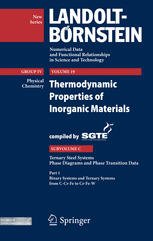

Most ebook files are in PDF format, so you can easily read them using various software such as Foxit Reader or directly on the Google Chrome browser.
Some ebook files are released by publishers in other formats such as .awz, .mobi, .epub, .fb2, etc. You may need to install specific software to read these formats on mobile/PC, such as Calibre.
Please read the tutorial at this link: https://ebookbell.com/faq
We offer FREE conversion to the popular formats you request; however, this may take some time. Therefore, right after payment, please email us, and we will try to provide the service as quickly as possible.
For some exceptional file formats or broken links (if any), please refrain from opening any disputes. Instead, email us first, and we will try to assist within a maximum of 6 hours.
EbookBell Team

0.0
0 reviewsFollowing the publication of a first set of four volumes of SGTE compiled thermodynamic properties of inorganic substances, which dealt with pure substances (Subvolume A) and a second set of five volumes with selected thermodynamic data for binary alloy systems (Subvolume B), this set of volumes focuses on data for ternary systems for one vitally important specific class of materials, steels. Various diagrams for each system are presented, calculated from a specially developed SGTE database for steels. Background information is also presented for each system. The fundamental equations used in evaluating the data are given in the introduction to the volumes and the models used in representing the data are also described.
For this volume a steel database has been compiled, consisting of 11 elements: Fe, C, N, Cr, Mn, Mo, Ni, Si, Ti, V, and W. With this selection of elements a broad range of steels and cast irons is covered. The database allows not only calculations within the included assessed systems but it is also capable of interpolating into regions which are not well-known. Typical steel databases are confined to the Fe-rich corner. Contrary to that the present compilation covers the composition range of all evaluated systems as much as possible.